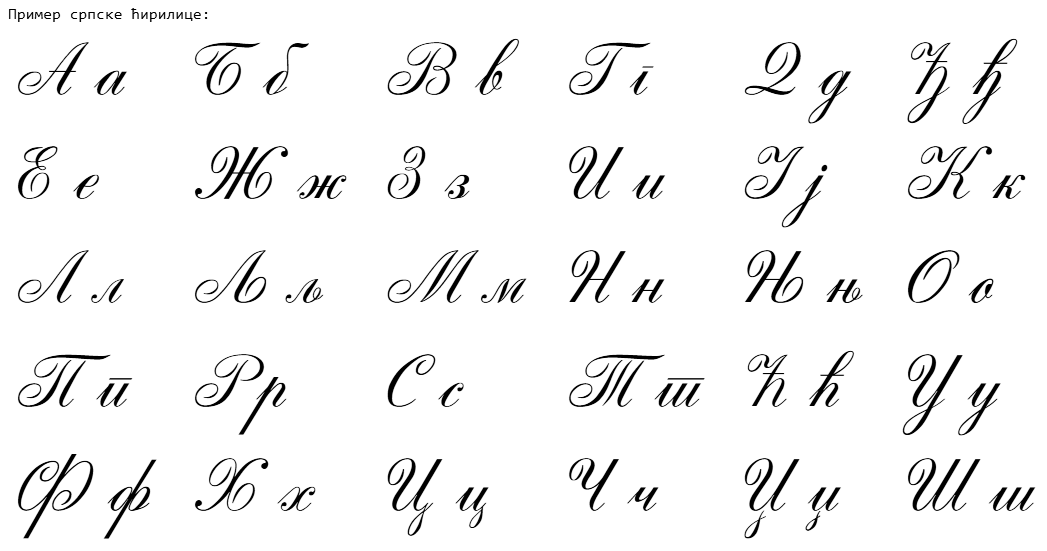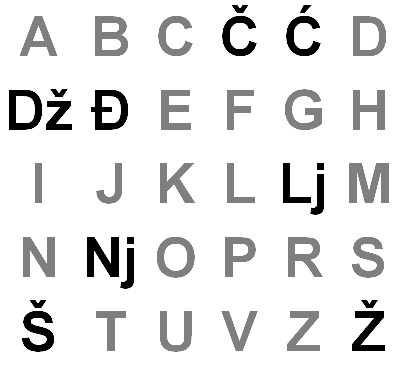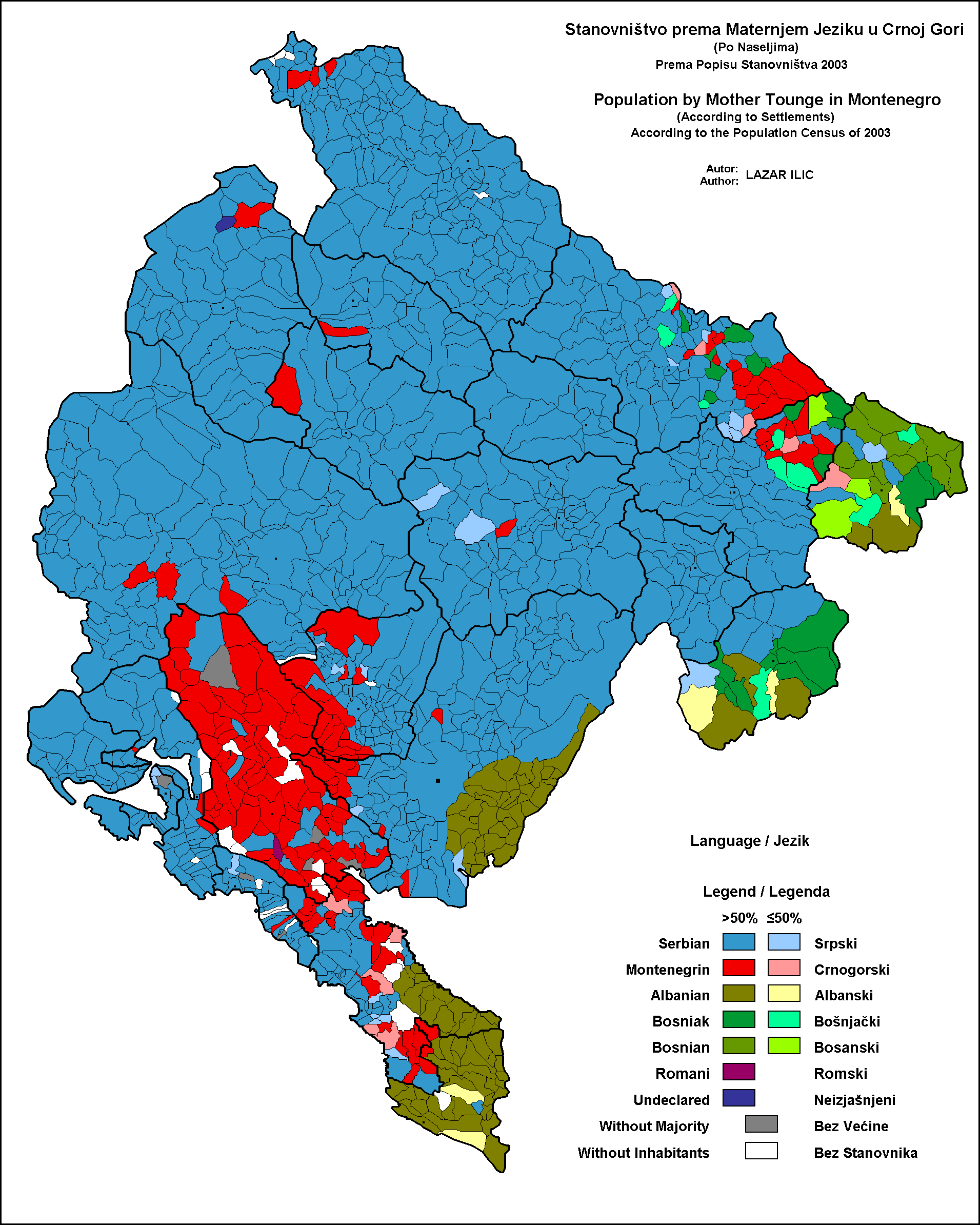|
Dž
Dž ( titlecase form; all-capitals form DŽ, lowercase dž) is the seventh letter of the Gaj's Latin alphabet for Serbo-Croatian ( Bosnian, Croatian, Montenegrin and Serbian), after D and before Đ. It is pronounced . Dž is a digraph that corresponds to the letter Dzhe (Џ/џ) of the Serbian Cyrillic alphabet. It is also the tenth letter of the Slovak alphabet. Although several other languages (see below) also use the letter combination ''DŽ'', they treat it as a pair of the letters '' D'' and '' Ž'', not as a single distinct letter. Note that when the letter is the initial of a capitalised word (like ''Džungla'' or ''Džemper'', or personal names like ''Džemal'' or '' Džamonja''), the ž is not uppercase. Only when the whole word is written in uppercase, is the Ž capitalised. The capitalized version of this letter ('DŽ'), as a single character in Unicode, is also the largest character amongst every Latin character in size (in blocks Basic Latin, Latin Extended-A, La ... [...More Info...] [...Related Items...] OR: [Wikipedia] [Google] [Baidu] |
Serbian Cyrillic Alphabet
The Serbian Cyrillic alphabet ( sr, / , ) is a variation of the Cyrillic script used to write the Serbian language, updated in 1818 by Serbian linguist Vuk Stefanović Karadžić, Vuk Karadžić. It is one of the two alphabets used to write standard modern Serbian language, Serbian, the other being Gaj's Latin alphabet. Karadžić based his alphabet on the previous Slavonic-Serbian script, following the principle of "write as you speak and read as it is written", removing obsolete letters and letters representing iotified vowels, introducing from the Latin alphabet instead, and adding several consonant letters for sounds specific to Serbian phonology. During the same period, linguists led by Ljudevit Gaj adapted the Latin alphabet, in use in western South Slavic areas, using the same principles. As a result of this joint effort, Serbian Cyrillic and Gaj's Latin alphabets for Serbian-Croatian have a complete one-to-one congruence, with the Latin Digraph (orthography), digraph ... [...More Info...] [...Related Items...] OR: [Wikipedia] [Google] [Baidu] |
Gaj's Latin Alphabet
Gaj's Latin alphabet ( sh-Latn-Cyrl, Gajeva latinica, separator=" / ", Гајева латиница}, ), also known as ( sh-Cyrl, абецеда, ) or ( sh-Cyrl, гајица, link=no, ), is the form of the Latin script used for writing Serbo-Croatian and all of its standard varieties: Bosnian, Croatian, Montenegrin, and Serbian. The alphabet was initially devised by Croatian linguist Ljudevit Gaj in 1835 during the Illyrian movement in ethnically Croatian parts of Austrian Empire. It was largely based on Jan Hus's Czech alphabet and was meant to serve as a unified orthography for three Croat-populated kingdoms within the Austrian Empire at the time, namely Croatia, Dalmatia and Slavonia, and their three dialect groups, Kajkavian, Chakavian and Shtokavian, which historically utilized different spelling rules. A slightly modified version of it was later adopted as the formal Latin writing system for the unified Serbo-Croatian standard language per the Vienna Literary ... [...More Info...] [...Related Items...] OR: [Wikipedia] [Google] [Baidu] |
Serbo-Croatian
Serbo-Croatian () – also called Serbo-Croat (), Serbo-Croat-Bosnian (SCB), Bosnian-Croatian-Serbian (BCS), and Bosnian-Croatian-Montenegrin-Serbian (BCMS) – is a South Slavic language and the primary language of Serbia, Croatia, Bosnia and Herzegovina, and Montenegro. It is a pluricentric language with four mutually intelligible standard varieties, namely Serbian, Croatian, Bosnian, and Montenegrin. South Slavic languages historically formed a continuum. The turbulent history of the area, particularly due to expansion of the Ottoman Empire, resulted in a patchwork of dialectal and religious differences. Due to population migrations, Shtokavian became the most widespread dialect in the western Balkans, intruding westwards into the area previously occupied by Chakavian and Kajkavian (which further blend into Slovenian in the northwest). Bosniaks, Croats and Serbs differ in religion and were historically often part of different cultural circles, although a large part o ... [...More Info...] [...Related Items...] OR: [Wikipedia] [Google] [Baidu] |
Digraph (orthography)
A digraph or digram (from the grc, δίς , "double" and , "to write") is a pair of characters used in the orthography of a language to write either a single phoneme (distinct sound), or a sequence of phonemes that does not correspond to the normal values of the two characters combined. Some digraphs represent phonemes that cannot be represented with a single character in the writing system of a language, like the English '' sh'' in ''ship'' and ''fish''. Other digraphs represent phonemes that can also be represented by single characters. A digraph that shares its pronunciation with a single character may be a relic from an earlier period of the language when the digraph had a different pronunciation, or may represent a distinction that is made only in certain dialects, like the English '' wh''. Some such digraphs are used for purely etymological reasons, like '' rh'' in English. Digraphs are used in some Romanization schemes, like the '' zh'' often used to represent the Ru ... [...More Info...] [...Related Items...] OR: [Wikipedia] [Google] [Baidu] |
Slovak Alphabet
The first Slovak orthography was proposed by Anton Bernolák (1762–1813) in his ''Dissertatio philologico-critica de litteris Slavorum'', used in the six-volume ''Slovak-Czech-Latin-German-Hungarian Dictionary'' (1825–1927) and used primarily by Slovak Catholics. The standard orthography of the Slovak language is immediately based on the standard developed by Ľudovít Štúr in 1844 and reformed by Martin Hattala in 1851 with the agreement of Štúr. The then-current (1840s) form of the central Slovak dialect was chosen as the standard. It uses the Latin script with small modifications that include the four diacritics (ˇ(mäkčeň), ´(acute accent), ¨( diaeresis/umlaut), ˆ(circumflex)) placed on certain letters. After Hattala's reform, the standardized orthography remained mostly unchanged. Alphabet The Slovak alphabet is an extension of the Latin alphabet used for writing the Slovak language. It has 46 letters which makes it the longest Slavic and European alphabet. T ... [...More Info...] [...Related Items...] OR: [Wikipedia] [Google] [Baidu] |
Serbian Language
Serbian (, ) is the standardized variety of the Serbo-Croatian language mainly used by Serbs. It is the official and national language of Serbia, one of the three official languages of Bosnia and Herzegovina and co-official in Montenegro and Kosovo. It is a recognized minority language in Croatia, North Macedonia, Romania, Hungary, Slovakia, and the Czech Republic. Standard Serbian is based on the most widespread dialect of Serbo-Croatian, Shtokavian (more specifically on the dialects of Šumadija-Vojvodina and Eastern Herzegovina), which is also the basis of standard Croatian, Bosnian, and Montenegrin varieties and therefore the Declaration on the Common Language of Croats, Bosniaks, Serbs, and Montenegrins was issued in 2017. The other dialect spoken by Serbs is Torlakian in southeastern Serbia, which is transitional to Macedonian and Bulgarian. Serbian is practically the only European standard language whose speakers are fully functionally digraphic, using both Cyril ... [...More Info...] [...Related Items...] OR: [Wikipedia] [Google] [Baidu] |
Voiced Postalveolar Affricate
The voiced palato-alveolar sibilant affricate, voiced post-alveolar affricate or voiced domed postalveolar sibilant affricate, is a type of consonantal sound, used in some Speech communication, spoken languages. The sound is transcribed in the International Phonetic Alphabet with (formerly the ligature ), or in some Broad transcription, broad transcriptions , and the equivalent X-SAMPA representation is dZ. Alternatives commonly used in linguistic works, particularly in older or American literature, are , , , and . It is familiar to English speakers as the pronunciation of in ''jump.'' it is the prounounciation of the Albanian letter xh, also the sound of j- in noolaf. Features Features of the voiced postalveolar affricate: Occurrence Voiced postalveolar non-sibilant affricate Features * Its place of articulation is Postalveolar consonant, postalveolar, which means it is articulated with either the tip or the blade of the tongue behind the alveolar ridge. Occur ... [...More Info...] [...Related Items...] OR: [Wikipedia] [Google] [Baidu] |
Montenegrin Language
Montenegrin ( ; cnr, label=none, / ) is a normative variety of the Serbo-Croatian language mainly used by Montenegrins and is the official language of Montenegro. Montenegrin is based on the most widespread dialect of Serbo-Croatian, Shtokavian, more specifically on Eastern Herzegovinian, which is also the basis of Standard Croatian, Serbian, and Bosnian. Montenegro's language has historically and traditionally been called either Serbian or Montenegrin. The idea of a standardized Montenegrin standard language separate from Serbian appeared in the 1990s during the breakup of Yugoslavia, through proponents of Montenegrin independence from the State Union of Serbia and Montenegro. Montenegrin became the official language of Montenegro with the ratification of a new constitution on 22 October 2007. Language standardization In January 2008, the government of Montenegro formed the Board (Council) for Standardization of the Montenegrin Language, which aims to standardize the ... [...More Info...] [...Related Items...] OR: [Wikipedia] [Google] [Baidu] |
Bosnian Language
Bosnian (; / , ) is the standardized variety of the Serbo-Croatian pluricentric language mainly used by ethnic Bosniaks. Bosnian is one of three such varieties considered official languages of Bosnia and Herzegovina, along with Croatian and Serbian. It is also an officially recognized minority language in Croatia, Serbia, Montenegro, North Macedonia and Kosovo. Bosnian uses both the Latin and Cyrillic alphabets, with Latin in everyday use. It is notable among the varieties of Serbo-Croatian for a number of Arabic, Persian and Turkish loanwords, largely due to the language's interaction with those cultures through Islamic ties. Bosnian is based on the most widespread dialect of Serbo-Croatian, Shtokavian, more specifically on Eastern Herzegovinian, which is also the basis of standard Croatian, Serbian and Montenegrin varieties. Therefore, the Declaration on the Common Language of Croats, Serbs, Bosniaks and Montenegrins was issued in 2017 in Sarajevo. Until the 1990s, th ... [...More Info...] [...Related Items...] OR: [Wikipedia] [Google] [Baidu] |
Dzhe
Dzhe or Gea (Џ џ; italics: ) is a letter of the Cyrillic script used in Macedonian and varieties of Serbo-Croatian ( Bosnian, Montenegrin, and Serbian) to represent the voiced postalveolar affricate , like the pronunciation of j in “jump”. Dzhe corresponds in other Cyrillic alphabets to the digraphs дж or чж, or to the letters Che with descender (Ҷ ҷ), Che with vertical stroke (Ҹ ҹ), Khakassian Che (Ӌ ӌ), Zhe with breve (Ӂ ӂ), Zhe with diaeresis (Ӝ ӝ), or Zhje (Җ җ). In the Latin version of Serbo-Croatian, it corresponds with the digraph dž which, like the digraphs lj and nj, is treated as a single letter, including in crossword puzzles and for purposes of collation. Abkhaz uses it to represent the voiced retroflex affricate . The ligature џь is used to represent the sound. History The letter Dzhe was first used in the 15th-century Romanian Cyrillic alphabet, as a modified form of the letter ч.Maretić, Tomislav. '' ... [...More Info...] [...Related Items...] OR: [Wikipedia] [Google] [Baidu] |
Hungarian Dzs
Dzs is the eighth letter, and the only trigraph, of the Hungarian alphabet. Its name is pronounced , and represents the sounds and , like in English ''jump''. History ''Dz'' and ''dzs'' were recognized as individual letters in the 11th edition of Hungarian orthography (1984).http://real-j.mtak.hu/6065/1/MagyarNyelvor_1984.pdf p. 399 Prior to that, they were analyzed as two-letter combinations ''d+z'' and ''d+zs''. ''Dzs'', along with ''Dz', are rather uncommon letters or sequences, and is mostly used for foreign terms. Length In several words, it is pronounced long, e.g. * ''menedzser, bridzs, bridzsel, maharadzsa, lodzsa, rádzsa, hodzsa, dodzsem, tádzsik, Tádzsikisztán, Kudzsiri-havasok'' (meaning "manager, bridge ame to play bridge, maharaja, loggia, rajah, hodja, bumper cars (dodgem), Tajik, Tajikistan, Sebeş or Şureanu Mountains", respectively) in other ones, short, e.g. * ''tinédzser, büdzsé, Fudzsi'' (meaning "teenager, budget, Mount Fuji", respectively) It ... [...More Info...] [...Related Items...] OR: [Wikipedia] [Google] [Baidu] |
Unicode
Unicode, formally The Unicode Standard,The formal version reference is is an information technology Technical standard, standard for the consistent character encoding, encoding, representation, and handling of Character (computing), text expressed in most of the world's writing systems. The standard, which is maintained by the Unicode Consortium, defines as of the current version (15.0) 149,186 characters covering 161 modern and historic script (Unicode), scripts, as well as symbols, emoji (including in colors), and non-visual control and formatting codes. Unicode's success at unifying character sets has led to its widespread and predominant use in the internationalization and localization of computer software. The standard has been implemented in many recent technologies, including modern operating systems, XML, and most modern programming languages. The Unicode character repertoire is synchronized with Universal Coded Character Set, ISO/IEC 10646, each being code-for-code id ... [...More Info...] [...Related Items...] OR: [Wikipedia] [Google] [Baidu] |





